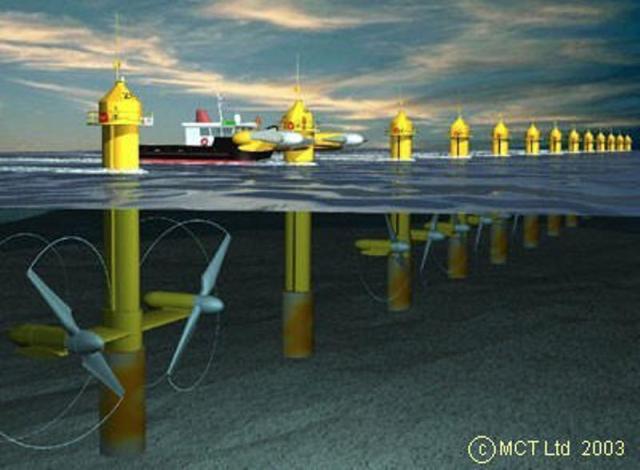Difference between revisions of "Arjan"
(Bijhsjhsauisadh asuhdiuashdasiudh iuashduiasdhuiasdhuasidh uiashduiahsd http://connect.mlive.com/user/buycialishere/index.html#44349 buy cialis canada - cialis http://connect.mlive.com/user/buyviagrah) |
|||
| (4 intermediate revisions by 3 users not shown) | |||
| Line 1: | Line 1: | ||
==Object from the Future== | |||
<br>[[Image:MarineTurbines.jpg]]<br><br> | |||
'''Tidal Power'''<br> | |||
The use of offshore underwater turbines using the tides to generate electricity is a relatively new concept of<br>creating clean energy. By using the current generated by the differences in low and high tide the movement of the<br>propeller, similar as a wind turbine, will provide the power necessary for a turbine to generate electricity.<br><br> | |||
'''New''' - The application of the propeller-powered turbine system for underwater purposes offers an entirely new<br>way to create clean energy. Although tidal and wave power applications have been under development for some<br>time the (modular) offshore underwater turbine system offers a relatively inexpensive and efficient solution for <br>clean energy generation.<br><br> | |||
'''Replace''' - With the end of the fossil fuels nearing the search for (clean) alternatives continues. Although the<br>above visualised system can only be used in areas with large differences in height between high and low tide<br>(twenty locations worldwide, often deep bays) it can contribute to the replacement of current energy generating<br>facilities.<br><br> | |||
'''Change''' - The use of water or the tides to generate electricity is more reliable then the sun and wind, because<br>water movement (especially the tides) is continuous, while the presence of the sun and wind are not. Using these<br>offshore underwater turbines can renew the attention for hydroelectric applications.<br><br> | |||
'''Growth''' - Only twenty locations worldwide have been appointed to be able to use the current system. This has<br>directly to do with the necessary difference in height between the high and low tide (several dozens of<br>centimetres). Currently the application of the system is considered in Argentina, Australia, Canada, India, Korea,<br>Mexico, the UK, the USA, and Russia. Once the system gets improved it might be applicable in more locations.<br><br> | |||
'''Other''' - The system is not yet sophisticated enough to offer a real attractive cost-revenue ratio. Furthermore<br>additional research needs to be done on the reliability of the hardware and its influence on the environment and<br>ecosystem.<br><br> | |||
'''References'''<br> | |||
http://www.e-tidevannsenergi.com/index.htm<br> | |||
http://www.energieportal.nl/waterkracht/review/energie_uit_water_de_verschillende_soorten_waterkracht.html<br> | |||
http://en.wikipedia.org/wiki/Tidal_power<br><br> | |||
18-03-06 | |||
Latest revision as of 12:22, 25 April 2013
Object from the Future
Tidal Power
The use of offshore underwater turbines using the tides to generate electricity is a relatively new concept of
creating clean energy. By using the current generated by the differences in low and high tide the movement of the
propeller, similar as a wind turbine, will provide the power necessary for a turbine to generate electricity.
New - The application of the propeller-powered turbine system for underwater purposes offers an entirely new
way to create clean energy. Although tidal and wave power applications have been under development for some
time the (modular) offshore underwater turbine system offers a relatively inexpensive and efficient solution for
clean energy generation.
Replace - With the end of the fossil fuels nearing the search for (clean) alternatives continues. Although the
above visualised system can only be used in areas with large differences in height between high and low tide
(twenty locations worldwide, often deep bays) it can contribute to the replacement of current energy generating
facilities.
Change - The use of water or the tides to generate electricity is more reliable then the sun and wind, because
water movement (especially the tides) is continuous, while the presence of the sun and wind are not. Using these
offshore underwater turbines can renew the attention for hydroelectric applications.
Growth - Only twenty locations worldwide have been appointed to be able to use the current system. This has
directly to do with the necessary difference in height between the high and low tide (several dozens of
centimetres). Currently the application of the system is considered in Argentina, Australia, Canada, India, Korea,
Mexico, the UK, the USA, and Russia. Once the system gets improved it might be applicable in more locations.
Other - The system is not yet sophisticated enough to offer a real attractive cost-revenue ratio. Furthermore
additional research needs to be done on the reliability of the hardware and its influence on the environment and
ecosystem.
References
http://www.e-tidevannsenergi.com/index.htm
http://www.energieportal.nl/waterkracht/review/energie_uit_water_de_verschillende_soorten_waterkracht.html
http://en.wikipedia.org/wiki/Tidal_power
18-03-06
